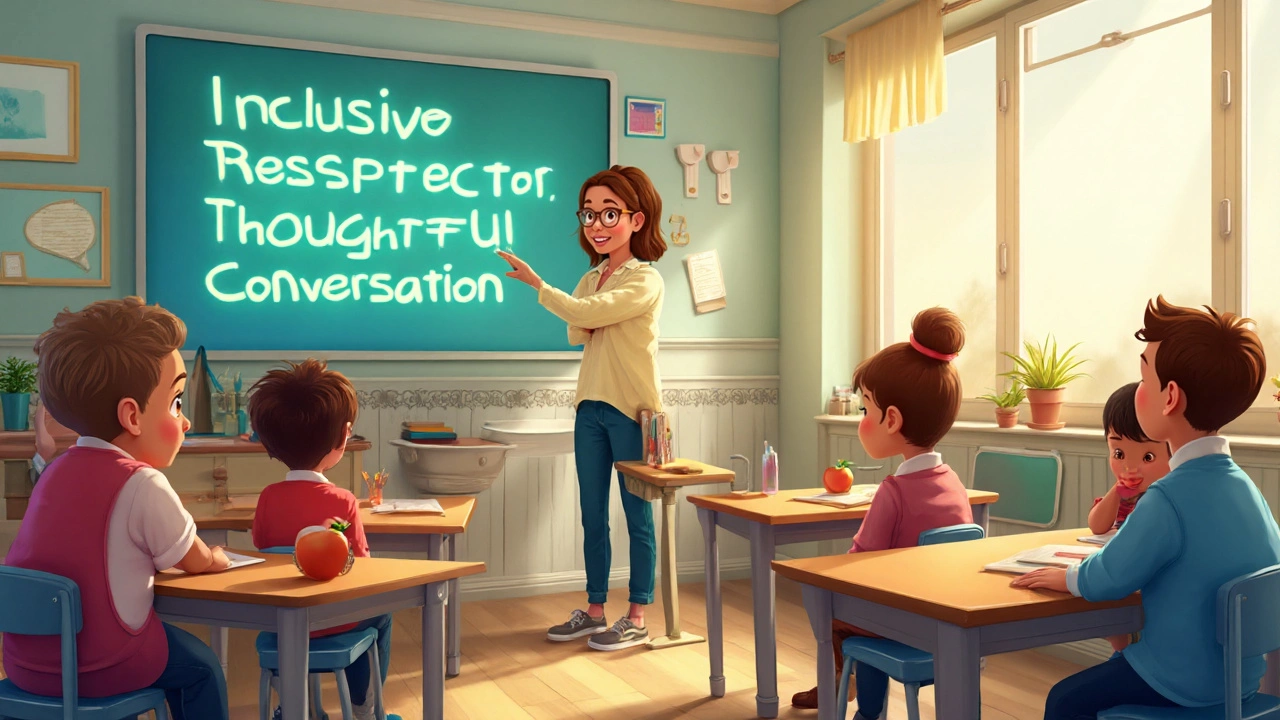Words can empower, or they can leave scars. The way we talk about people with disabilities often says more about society than about the person we're referencing. Just a few decades ago, the phrase 'special needs' felt progressive, even compassionate. Fast forward to 2025, and you’ll see that this term is being replaced by language that aims for clarity, dignity, and belonging. If you’ve ever worried about slipping up or felt awkward when choosing the right term, you’re not alone. So, what’s the most polite, respectful, and current way to talk about those who were once called 'special needs'?
How Language Shapes Attitudes: Why Terms Matter
Language sits right at the heart of how people see each other. When it comes to disabilities, what we say can directly affect someone’s identity, sense of acceptance, and the way the world treats them. ‘Handicapped’ was all over public signs through the 1980s, but by the 1990s, most folks thought it sounded outdated, or even offensive. The shift to 'special needs' felt more gentle, but it also came with its own baggage — a kind of sugarcoating that gave some people the sense they were being talked down to. Nobody wants to feel like they’re being tiptoed around or that their lives are being described in vague, patronizing terms.
Actually, a 2020 study from Syracuse University asked people with disabilities how they felt about ‘special needs.’ Nearly 700 respondents, many of them parents and self-advocates, overwhelmingly said they preferred clear, direct language: ‘disabled’ or ‘person with a disability.’ The researchers found that 'special needs' was often linked to negative stereotypes and even exclusion. This is a big deal. It means many people with disabilities don’t actually want to be called 'special needs'—they want language that is straightforward, unambiguous, and just factual.
So, does that mean 'special needs' is always offensive? Not quite. In some circles—especially in educational settings or pediatric health care—it’s still used because of legal or institutional habits. But if you want to be polite and keep up with the times, 'person with a disability' is your safest bet. This approach, called person-first language, puts the person before their disability. You’ll hear phrases like 'student with autism,' or 'child who uses a wheelchair.' Some communities, particularly in the UK and parts of North America, also use identity-first language—'disabled person'—to capture pride and solidarity. Both are considered respectful as long as you’re not deliberately using a label someone dislikes.
Here’s something else that surprises a lot of folks: people are trending toward asking directly, 'What language do you prefer?' It’s like asking someone if they go by 'Robert' or 'Rob.' Being upfront is often the most polite option of all.
| Term | Perceived Politeness (1-5) | Usage Trend (2024 Data) |
|---|---|---|
| Special needs | 2.5 | Falling |
| Handicapped | 1.0 | Almost obsolete |
| Disabled person | 4.0 | Rising |
| Person with a disability | 5.0 | Rising |
| Differently abled | 3.0 | Controversial |
| Neurodivergent | 4.5 | Rising (for neuro-disabilities) |
This table gives you a quick snapshot: 'person with a disability' and 'disabled person' both score highly for politeness and authenticity, while 'special needs' is losing ground. Interesting, right?

Navigating Conversations: Practical Tips and Real-World Examples
Picture this: you’re at a school event and a parent introduces you to their daughter who uses a communication device. What do you say? Do you mention her disability? How do you phrase things if it comes up? This is where things get real, and awkwardness can creep in if you’re out of practice.
Here’s a cheat sheet—honed from disability advocates, etiquette trainers, and people living this experience every day:
- Use inclusive language: Refer to “students with disabilities,” “children with autism,” or simply use the child’s name just like anyone else.
- Don’t whisper or avoid the topic: If a disability is relevant, it’s fine to talk about it. Just be clear and honest. For example, 'She uses a wheelchair,' is fine. What’s not cool? Mushy euphemisms like 'differently abled' (unless that’s the person’s own preference—some do like it!). Many see these as minimizing real barriers and challenges.
- If you’re unsure, just ask: 'How do you like to be referred to?' or 'Is there language you prefer?' Most people appreciate the respect in asking—much more than hearing an awkward guess or a phrase that feels outdated.
- Follow the community. Some groups do prefer identity-first (like “autistic person”). If you see people openly using this language, it’s safe to follow their lead.
- Be mindful of context: In legal documents or medical forms, the wording might be slow to change. In everyday talk, lead with how the person wants to be seen.
Let’s be real for a second—everyone is going to mess up once in a while. If you use the wrong word and someone corrects you, a quick 'Thank you, I’ll remember that' goes a long way. It’s not about getting it flawless every time, but about caring enough to get it right.
Here’s a real-world tip: If you work in education, health care, or even customer service, make a habit of updating your language every year. There’s no shame in Googling current preferred terms—or better yet, checking sites run by self-advocates like the Autistic Self Advocacy Network or the Disability Rights Education & Defense Fund. They’re often ahead of the curve.
And don’t underestimate the power of modeling. If you’re a teacher, the words you use shape the culture for your whole classroom. If parents see you saying 'person with a disability' instead of 'special needs student,' they’ll usually follow suit.

Down to the Details: What’s Polite, What’s Not, and Why It Keeps Changing
So why do these terms change so much? Honestly, because people’s needs and sense of identity keep changing too. Culture shifts, laws update, communities find more empowering words, and language follows. Here’s a snapshot from just the last five years. The federal Individuals with Disabilities Education Act (IDEA) didn’t mention 'special needs'—it used 'children with disabilities' right from its start. In the UK, They once used 'Special Educational Needs (SEN)' in schools, but now even there, you'll hear ‘additional support needs’ or just ‘disabled students’ more often, usually at families’ request.
When Harvard’s Project Implicit did a survey in 2023, out of 12,000 respondents, twice as many preferred 'disability' or 'disabled' to 'special needs.' Advocates point out that the word 'special' sometimes sounds like a code word for 'different in a bad way.' It can be a little cringey, like saying “special bus” or “special class.” Nobody wants to feel segregated or pitied. The preference for “person with a disability” is about owning the facts, not pushing them under the rug.
But don’t write off context. In some school districts or hospital systems, paperwork still uses the old terms—and that’s okay for now while things catch up. If you’re writing a policy or talking with someone unfamiliar, pair the terms: “children with disabilities, sometimes called special needs.” This helps bridge that language gap.
What about trendy phrases like “differently abled” or “diverse abilities?” Here’s where things get tricky. A few people love them and feel empowered; others say these words feel like trying too hard to dodge the reality of disability. If someone introduces themselves with these terms, use what they use. Otherwise? Stick with what disability organizations recommend: 'person with a disability' or 'disabled person.'
For kids, there’s another layer—it’s not just about adults. Kids notice labels, fast. One 2024 after-school survey in New York found that when students heard the word 'disability,' nearly half felt empathy or curiosity, while only 10% said it sounded negative. 'Special needs,' on the other hand, made kids more likely to avoid or feel unsure about their peers. This matters—a lot. Kids learn how to include (or exclude) others based on what they hear early on.
If you’re hiring, teaching, or just working alongside someone with a disability, respectful language is the first step toward true inclusion. Swap out 'special needs' for 'person with a disability.' Don’t dwell on the disability unless it’s directly relevant. Focus on the person’s strengths, like you would with anyone else.
Here’s a quick wrap-up of the key moves:
- Politeness comes from respect and listening—ask people what they prefer.
- 'Person with a disability' is the most accepted, polite term in 2025.
- Avoid euphemisms unless you know for sure someone prefers them. Specificity beats vague positivity.
- Model the best language in public—people pay attention and often copy what you say.
- Stay curious, and be ready to update your vocabulary as the world keeps evolving.
Language isn’t just about being politically correct. It's about giving everyone dignity. If you’re still stumped, remember: you can always ask. Most people will appreciate your effort and honesty far more than a perfect piece of phrasing.

